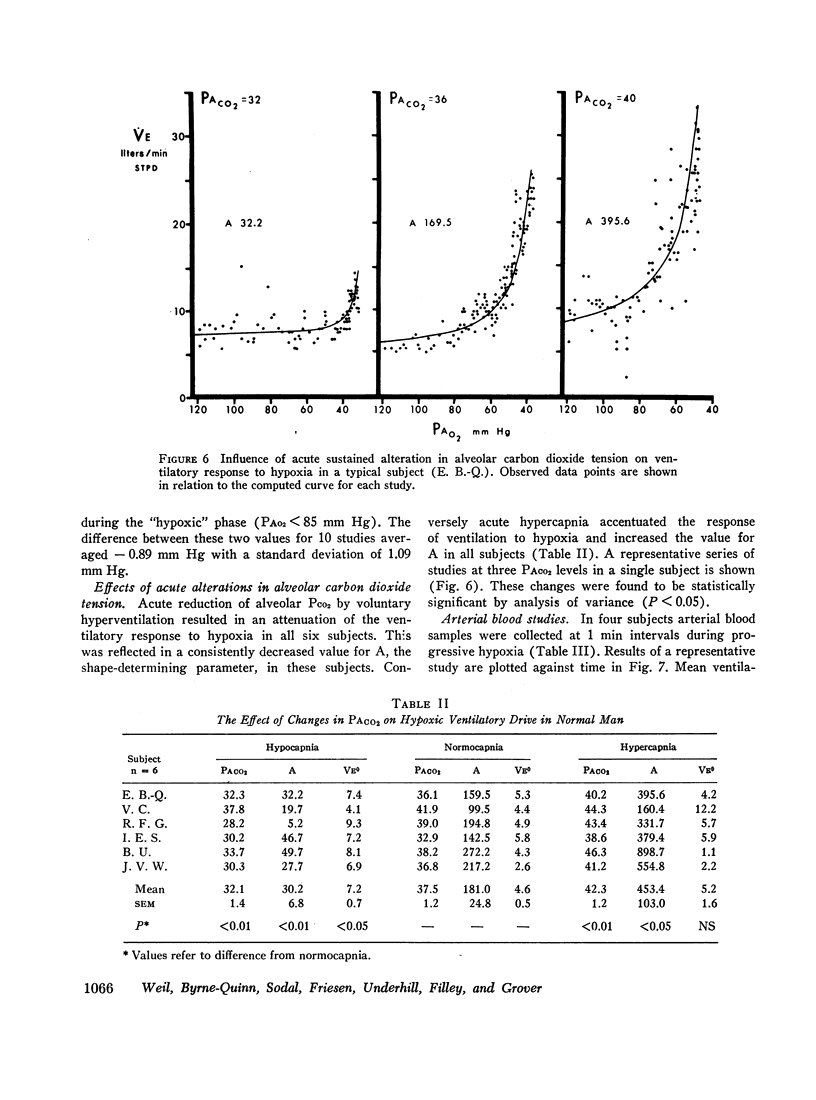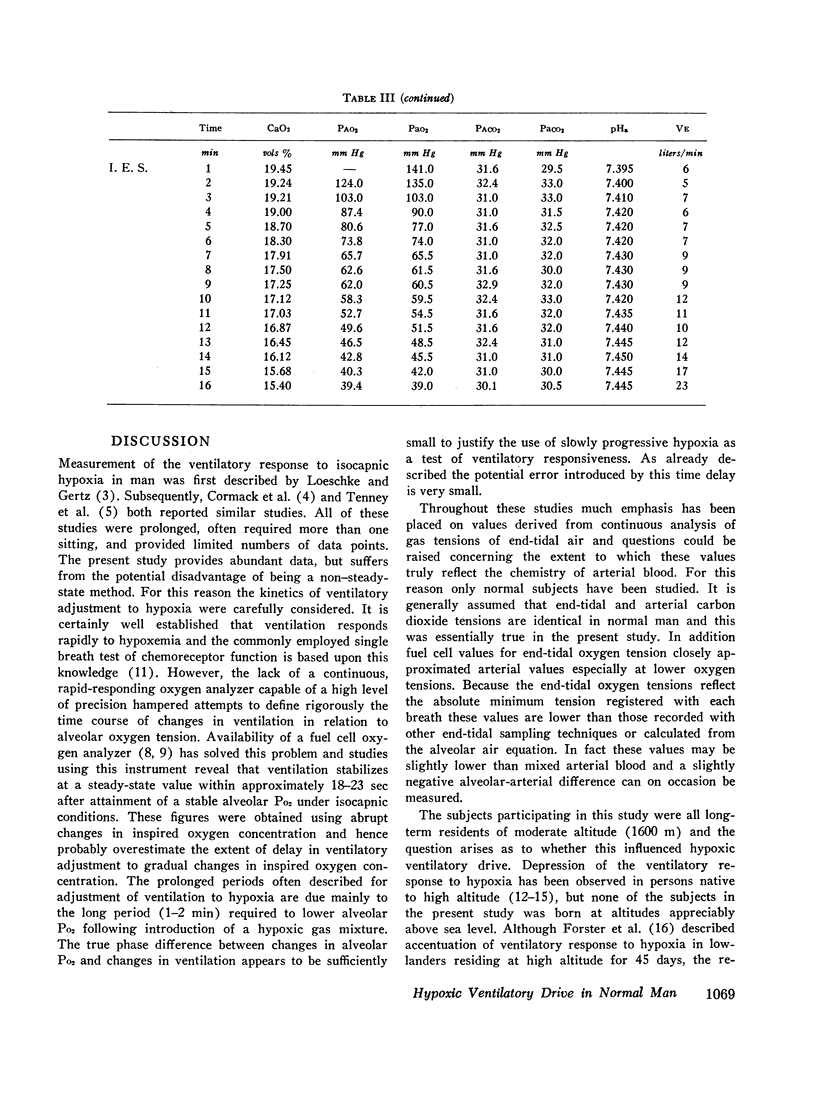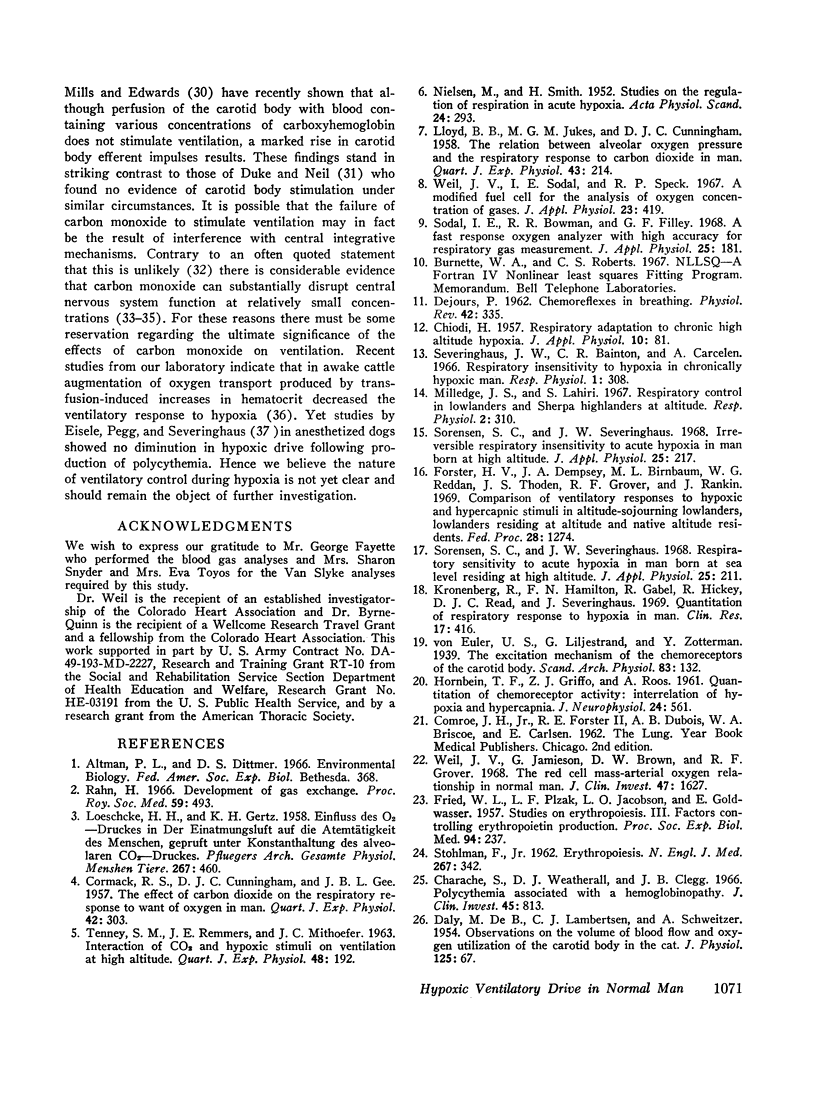Abstract
A technique is described which permits the inscription of the ventilatory response to isocapnic hypoxia in man as a continuous curve relating alveolar oxygen tension and minute ventilation. The adjustment of ventilation to changes in alveolar oxygen tension is complete in 18-23 sec and this is sufficiently rapid to justify the use of a non-steady-state method. Changes in alveolar carbon dioxide tension are prevented by addition of carbon dioxide to the inspired gas. The resulting [unk]VE-PAo2 curves are hyperbolic such that falling PAo2 produces only slight rises in [unk]VE until a critical PAo2 range of 50-60 mm Hg is reached. With further fall in PAo2, [unk]VE increases steeply and the slope of the curve approaches infinity at a tension of 30-40 mm Hg. For purposes of quantitation these curves are approximated by a simple hyperbolic function, the parameters of which are evaluated by a least squares fit of the data. The parameter A denotes curve shape such that the higher the value of A. the greater the increase in ventilation for a given decrease in PAo2 and hence the greater the hypoxic drive. Curves are highly reproducible for each subject and curves from different subjects are similar. In 10 normal subjects at resting PACo2, A = 180.2 ±14.5 (SEM). When PACo2 is adjusted to levels 5 mm Hg above and below control in six subjects A = 453.4 ±103 and 30.2 ±6.8 respectively. These latter values differed significantly from control (P < 0.05). These changes in curve shape provide a clear graphic description of interaction between hypercapnic and hypoxic ventilatory stimuli. At normal PACo2 the [unk]VE-PAo2 curve has an inflection zone located over the same Po2 range as the inflection in the oxygen-hemoglobin dissociation curve. This indicated that ventilation might be a linear function of arterial oxygen saturation or content. Studies in four subjects have demonstrated that ventilation is indeed related to arterial oxygen content in a linear fashion. These data suggest, but do not prove, that oxygen tension in chemoreceptor tissue as in part determined by circulatory oxygen delivery may be an important factor in controlling the ventilatory response to hypoxia.
Full text
PDF











Selected References
These references are in PubMed. This may not be the complete list of references from this article.
- Beard R. R., Wertheim G. A. Behavioral impairment associated with small doses of carbon monoxide. Am J Public Health Nations Health. 1967 Nov;57(11):2012–2022. doi: 10.2105/ajph.57.11.2012. [DOI] [PMC free article] [PubMed] [Google Scholar]
- Bisgard G. E., Alvarez H. G., Grover R. F. Decreased ventilatory response to hypoxia during acute polycythemia in the calf. Respir Physiol. 1969 Oct;7(3):369–382. doi: 10.1016/0034-5687(69)90020-6. [DOI] [PubMed] [Google Scholar]
- CHIODI H. Respiratory adaptations to chronic high altitude hypoxia. J Appl Physiol. 1957 Jan;10(1):81–87. doi: 10.1152/jappl.1957.10.1.81. [DOI] [PubMed] [Google Scholar]
- CORMACK R. S., CUNNINGHAM D. J., GEE J. B. The effect of carbon dioxide on the respiratory response to want of oxygen in man. Q J Exp Physiol Cogn Med Sci. 1957 Jul;42(3):303–319. doi: 10.1113/expphysiol.1957.sp001266. [DOI] [PubMed] [Google Scholar]
- Charache S., Weatherall D. J., Clegg J. B. Polycythemia associated with a hemoglobinopathy. J Clin Invest. 1966 Jun;45(6):813–822. doi: 10.1172/JCI105397. [DOI] [PMC free article] [PubMed] [Google Scholar]
- DE BURGH DALY M., LAMBERTSEN C. J., SCHWEITZER A. Observations on the volume of blood flow and oxygen utilization of the carotid body in the cat. J Physiol. 1954 Jul 28;125(1):67–89. doi: 10.1113/jphysiol.1954.sp005143. [DOI] [PMC free article] [PubMed] [Google Scholar]
- DEJOURS P. Chemoreflexes in breathing. Physiol Rev. 1962 Jul;42:335–358. doi: 10.1152/physrev.1962.42.3.335. [DOI] [PubMed] [Google Scholar]
- DUKE H. N., GREEN J. H., NEIL E. Carotid chemoceptor impulse activity during inhalation of carbon monoxide mixtures. J Physiol. 1952 Dec;118(4):520–527. doi: 10.1113/jphysiol.1952.sp004813. [DOI] [PMC free article] [PubMed] [Google Scholar]
- Eisele J. H., Pegg J., Severinghaus J. W. Ventilatory response to hypoxia in acutely polycythemic dogs. J Appl Physiol. 1969 Jun;26(6):757–759. doi: 10.1152/jappl.1969.26.6.757. [DOI] [PubMed] [Google Scholar]
- FRIED W., GOLDWASSER E., JACOBSON L. O., PLZAK L. F. Studies on erythropoiesis. III. Factors controlling erythropoietin production. Proc Soc Exp Biol Med. 1957 Jan;94(1):237–241. doi: 10.3181/00379727-94-22910. [DOI] [PubMed] [Google Scholar]
- Forster H. V., Dempsey J. A., Birnbaum M. L., Reddan W. G., Thoden J. S., Grover R. F., Rankin J. Comparison of ventilatory responses to hypoxic and hypercapnic stimuli in altitude-sojourning lowlanders, lowlanders residing at altitude and native altitude residents. Fed Proc. 1969 May-Jun;28(3):1274–1279. [PubMed] [Google Scholar]
- HORNBEIN T. F., GRIFFO Z. J., ROOS A. Quantitation of chemoreceptor activity: interrelation of hypoxia and hypercapnia. J Neurophysiol. 1961 Nov;24:561–568. doi: 10.1152/jn.1961.24.6.561. [DOI] [PubMed] [Google Scholar]
- Klausen K., Rasmussen B., Gjellerod H., Madsen H., Petersen E. Circulation, metabolism and ventilation during prolonged exposure to carbon monoxide and to high altitude. Scand J Clin Lab Invest Suppl. 1968;103:26–38. [PubMed] [Google Scholar]
- LLOYD B. B., JUKES M. G., CUNNINGHAM D. J. The relation between alveolar oxygen pressure and the respiratory response to carbon dioxide in man. Q J Exp Physiol Cogn Med Sci. 1958 Apr;43(2):214–227. doi: 10.1113/expphysiol.1958.sp001319. [DOI] [PubMed] [Google Scholar]
- LOESCHCHKE H. H., GERTZ K. H. Einfluss des O2-Druckes in der Einatmungsluft auf die Atemtätigkeit des Menschen, geprüft unter Konstanthaltung des alveolaren CO2-Druckes. Pflugers Arch. 1958;267(5):460–477. doi: 10.1007/BF00361733. [DOI] [PubMed] [Google Scholar]
- Milledge J. S., Lahiri S. Respiratory control in lowlanders and Sherpa highlanders at altitude. Respir Physiol. 1967 May;2(3):310–322. doi: 10.1016/0034-5687(67)90036-9. [DOI] [PubMed] [Google Scholar]
- Mills E., Edwards M. W., Jr Stimulation of aortic and carotid chemoreceptors during carbon monoxide inhalation. J Appl Physiol. 1968 Nov;25(5):494–502. doi: 10.1152/jappl.1968.25.5.494. [DOI] [PubMed] [Google Scholar]
- NIELSEN M., SMITH H. Studies on the regulation of respiration in acute hypoxia; with a appendix on respiratory control during prolonged hypoxia. Acta Physiol Scand. 1952 Feb 12;24(4):293–313. doi: 10.1111/j.1748-1716.1952.tb00847.x. [DOI] [PubMed] [Google Scholar]
- Rahn H. Evolution of the gas transport system in vertebrates. Proc R Soc Med. 1966 Jun;59(6):493–494. doi: 10.1177/003591576605900608. [DOI] [PMC free article] [PubMed] [Google Scholar]
- SCHULTE J. H. EFFECTS OF MILD CARBON MONOXIDE INTOXICATION. Arch Environ Health. 1963 Nov;7:524–530. doi: 10.1080/00039896.1963.10663580. [DOI] [PubMed] [Google Scholar]
- STOHLMAN F., Jr Erythropoiesis. N Engl J Med. 1962 Aug 16;267:342–348. doi: 10.1056/NEJM196208162670707. [DOI] [PubMed] [Google Scholar]
- Severinghaus J. W., Bainton C. R., Carcelen A. Respiratory insensitivity to hypoxia in chronically hypoxic man. Respir Physiol. 1966;1(3):308–334. doi: 10.1016/0034-5687(66)90049-1. [DOI] [PubMed] [Google Scholar]
- Sodal I. E., Bowman R. R., Filley G. F. A fast-response oxygen analyzer with high accuracy for respiratory gas measurement. J Appl Physiol. 1968 Aug;25(2):181–183. doi: 10.1152/jappl.1968.25.2.181. [DOI] [PubMed] [Google Scholar]
- Sorensen S. C., Severinghaus J. W. Irreversible respiratory insensitivity to acute hypoxia in man born at high altitude. J Appl Physiol. 1968 Sep;25(3):217–220. doi: 10.1152/jappl.1968.25.3.217. [DOI] [PubMed] [Google Scholar]
- Sorensen S. C., Severinghaus J. W. Respiratory sensitivity to acute hypoxia in man born at sea level living at high altitude. J Appl Physiol. 1968 Sep;25(3):211–216. doi: 10.1152/jappl.1968.25.3.211. [DOI] [PubMed] [Google Scholar]
- TENNEY S. M., REMMERS J. E., MITHOEFER J. C. Interaction of CO2 and hypoxic stimuli on ventilation at high altitude. Q J Exp Physiol Cogn Med Sci. 1963 Apr;48:192–201. doi: 10.1113/expphysiol.1963.sp001651. [DOI] [PubMed] [Google Scholar]
- Weil J. V., Jamieson G., Brown D. W., Grover R. F. The red cell mass--arterial oxygen relationship in normal man. Application to patients with chronic obstructive airway disease. J Clin Invest. 1968 Jul;47(7):1627–1639. doi: 10.1172/JCI105854. [DOI] [PMC free article] [PubMed] [Google Scholar]
- Weil J. V., Sodal I. E., Speck R. P. A modified fuel cell for the analysis of oxygen concentration of gases. J Appl Physiol. 1967 Sep;23(3):419–422. doi: 10.1152/jappl.1967.23.3.419. [DOI] [PubMed] [Google Scholar]


